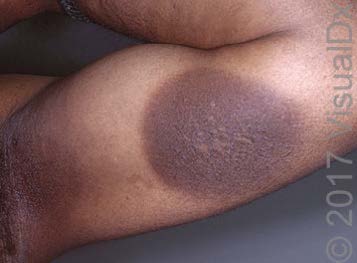Published on

Differential Diagnosis
- Contact dermatitis
- Drug-induced phototoxic reaction
- Fixed drug eruption
- Lichen planus
Diagnosis
This patient was diagnosed with a fixed drug eruption (FDE), a cutaneous drug reaction marked by sharply demarcated, typically round red patches that recur at the same body site each time an affected individual is re-exposed to the culprit drug.
Learnings
- Red patches associated with FDE may vary from 0.5 cm to several centimeters in size. Though usually asymptomatic, they may be associated with burning, pain, or pruritus.
- Any cutaneous surface may be affected, but the oral and anogenital mucosa are involved most frequently.
- Treatment consists of eliminating the causative drug, if possible. First-generation antihistamines, mild topical steroids, and moisturizing lotions may be helpful in reducing symptoms.
- Drug classes most commonly associated with FDE include antibiotics (especially sulfonamides, trimethoprim, fluoroquinolones, and tetracyclines), nonsteroidal anti-inflammatory medications (including naproxen, ibuprofen, and celecoxib), and barbiturates. Other specific implicated drugs include amoxicillin, erythromycin, metronidazole, fluconazole, paracetamol (acetaminophen), cetirizine, hydroxyzine, methylphenidate, oral contraceptives, quinine, and phenolphthalein. A nonpigmenting variant is seen with pseudoephedrine.
A 22-Year-Old Man with an Itchy Patch of Skin
1 2
